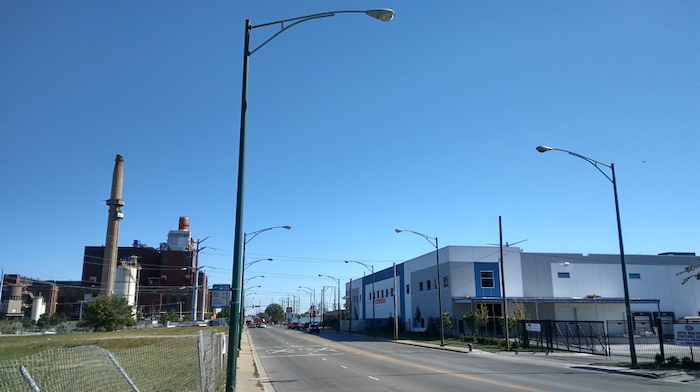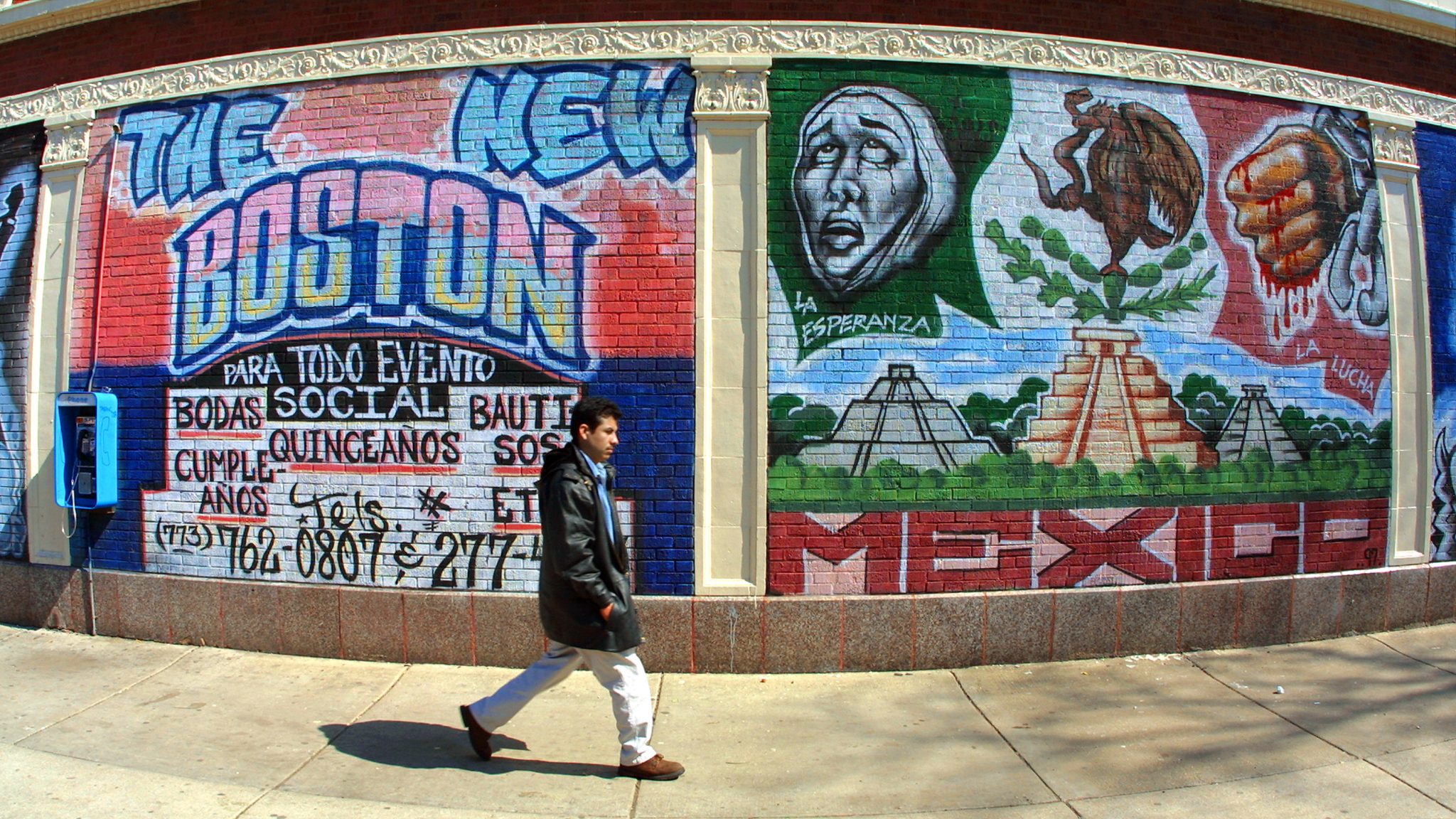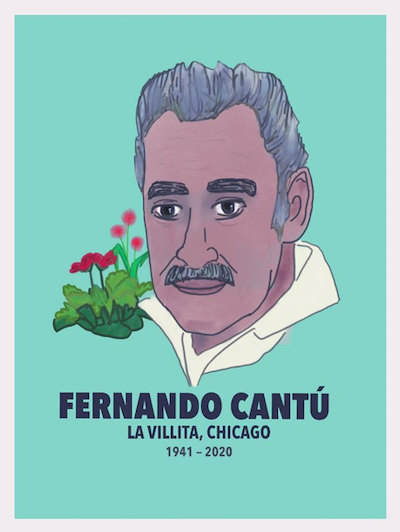By Dr. John D. Márquez and Dr. A.R. López
CHICAGO — The COVID-19 pandemic has stirred new dialogue regarding how race and class shape ecologies and health disparities in U.S. cities. It’s conventional wisdom now that communities hardest struck by the pandemic are already spaces of systematically designed and excessive harm and suffering.
On April 11, and with less than a 24-hour notice from city officials, residents of the Little Village (La Villita) neighborhood in Chicago witnessed the implosion of a massive smokestack that was part of the nearby Crawford Coal Plant. The implosion devastated the air quality of their densely populated neighborhood and spread fear amongst its residents.
La Villita is one of Chicago’s largest and oldest Latinx barrios. Most of its residents are working-class and the neighborhood is home to an estimated twenty thousand undocumented immigrants. After a large and slow-moving plume covered their homes, backyards, and vehicles in toxic particulate matter, community members were outraged and wanted answers. They were already facing a state mandated lockdown due to the COVID-19 pandemic, which further compromised their respiratory health.
Local residents and environmental justice activists expressed outraged at Hilco Redevelopment Partners, Mayor Lori Lightfoot, and Alderman Mike Rodriguez, who they held responsible. They questioned how a dangerous demolition was approved at the height of a global pandemic and in an area of the city that already suffers from the second worst air quality in the state of Illinois. They wondered why the demolition was not postponed if the coronavirus rapidly attacks the respiratory system?
A Tale of Race, Class, and Space
Structural inequality and segregation have been well documented in Chicago. The events of April 11, however, are yet another example of how society must advance beyond conventional reforms. We argue that those events reflect a society functioning as it was designed to do. This mandates a radical departure and a critical scrutiny of how race and capitalism function to produce harm. Chicago is unique and yet similar to all cities. Some parts of cities are more susceptible to pandemics, toxic air, toxic water, and police terror than are others. Safe space is never made without unsafe space. They are mutually constitutive.
Capitalism, as theorized by Henri Lefebvre and Edward Soja, shapes how spatial boundaries are made, sustained, and valued. It is a violent process mandated by the very ideas of private property, industry, and the systems of governance that are designed to protect them. Space is essential to the production of surplus from which capitalism functions or from which value is placed into motion. Surplus derives from a violent seizure and enclosure of land and a control of the lives of workers within it. This is both how and why some neighborhoods are referred to as working-class.


The Crawford plant next to new warehouse (Photo by A.R. López)
Ruth Wilson Gilmore and Laura Pulido have shown that racial knowledge informs this process. They show how capitalism makes and keeps space and labor and in ways that usually imperil the lives of working-class people of color. The union of race and class makes the racialized poor vulnerable to either forced relocation, exploitation, or environmental hazards. Race and class influence even the air we breathe. People live in dangerous places because they are forced to by socio-economic realities. In the U.S., these realities have always been produced by and through racial knowledge.
Once publicized as a gleaming modern or “White City” during the 1893 World’s Fair, Chicago is a quintessential example of what Cedric Robinson famously referred to as “racial capitalism.” Capitalism, in his theorization, never functions in isolation. Race always pre-authorizes harm. Preconceived notions of whose lives are expendable, removable, or exploitable underlie or fuel the development of capitalist formations. Racial capitalism functions through the violent seizure, marking, and control of land, life, and labor. Race determines who is removable from a land whenever such land is to be enclosed to inaugurate a capitalist development whose boundaries will be overseen by the state’s law enforcement apparatuses. In Chicago’s initial stages of urban growth, indigenous people were dispossessed and forced to relocate elsewhere. Chicago was celebrated as an Imperial City by the Lake—a modern settler city whose spatial borders secured European settlers from the savage surroundings of the western frontier.
Racial capitalism also violently produces exploitable labor. The labor needed to build the U.S. political economy was irrefutably wrought from the violent control of Black bodies and labor within the spatial boundaries of southern slave plantations. Northern industrial cities like Chicago largely derived from capital accumulated in this way. Chicago’s early industries also depended upon the arrival and control of migrant labor, initially from Eastern European countries, and then from African Americans, Mexicans, and Puerto Ricans displaced by the violence of racial capitalism elsewhere.
Those European or white ethnic groups comprised much of Chicago’s early industrial workforce. They, however, embraced whiteness and used vigilante violence in their attempts to control urban space and ascend beyond a permanence within a growing urban working-class. Their violence was often backed by local law enforcement authorities to quarantine or segregate workers of color in spaces where they would be most exploitable. As the post-WWII U.S. political economy adapted to pressures of neoliberalism and a post-fordism, the de-industrialization of Chicago has made much of its Black and Brown population surplus to the labor demands of industry. Thus, residents of communities like La Villita have become even more economically vulnerable as work dissipates and factories are closed. This has made them targets removal via mass incarceration.


In this archive photo, a man walks in front of a wall mural March 21, 2001 in Chicago’s Little Village neighborhood. (Photo by Tim Boyle/Newsmakers)
Memories of displacement, confinement, exploitation, and punishment produce an intergenerational trauma in communities like La Villita. It is thus not by chance that La Villita is one among many of Chicago’s neighborhoods where conditions like intra-group gun violence, crime, domestic violence, police brutality, and addiction are also rampant. Forced confinement breeds anxiety and despair. Anxiety, despair, and poverty produce behaviors that local authorities use to pathologize communities as deserving of hyper-surveillance and aggressive policing. Laquan McDonald (a 17 year-old African American male) was shot sixteen times by Chicago police officers in 2014 at a location that is only three miles away from where the Crawford coal stack was imploded in 2020. That was not by chance. It’s also not by chance that La Villita sits in close proximity to the Cook County Jail, one of the largest urban jails in the world. Cook County Jail is a daily, spatial, and visible reminder to La Villita’s residents of how spatial entrapment is enforced. Cook County Jail, furthermore, once had the highest rate of COVID-19 infection per space in the U.S. To this end, La Villita’s residents had plenty to worry about regarding their health on the morning of April 11, 2020 when the sky turned brown and toxins rained down upon them.
Because it envelops and harms entire communities at once and in a comprehensive way the condition that Robert Bullard termed, “environmental racism,” represents one of the more violent or destructive outcomes of racial capitalism because it pertains to the production and control of space. It’s an everyday and ever-present threat to life, a slow and persistent killer. David Pellow has mapped how Chicago’s Black or Brown communities have been created near polluting industrial waste dumps. This is not by chance. Those same communities, according to Rashad Shabazz, are spaces where police brutality and hyper-surveillance have harmed Black or Brown life for decades.
The COVID-19 pandemic has laid much of these realities bare and has stirred new dialogue regarding how race and class shape ecologies and health disparities in cities. It bears repeating, communities that have been the hardest struck by the pandemic are already spaces of systematically designed and excessive harm and suffering. Local government and industry would never implode a smokestack during a pandemic in one of Chicago’s wealthier and whiter north side neighborhoods.
The Struggle for Life in La Villita
Where there is despair and harm, there is always resistance. Where life is systemically obstructed, there is always a radical will to live on. Freedom is not a place. No one can give it to you. It’s not a noun. Freedom is a way of life, a method to live, or a state of being. Freedom is represented by our will and effort to fight for our lives whenever harm confronts us.
That fight can also be found in La Villita and it is inspiring. As per usual, it has been women who have been at the forefront of freedom struggles in their home spaces. For environmental justice leaders, the Crawford stack implosion was distinctly blatant. Having organized for over a decade to close the coal plant in 2012, the Little Village Environmental Justice Organization (LVEJO) and other EJ groups were successful in demarcating the Crawford and Fisk coal plants as known sites of environmental racism in Chicago’s Latinx communities. Grassroots leaders often pointed to a Harvard School of Public Health Study that estimated the Crawford coal plant was responsible for 41 premature deaths, 550 emergency room visits and 2,800 asthma attacks every year. In a neighborhood often represented as hyper-violent in the media for fast acts of gang violence, EJ activists constantly named the Crawford plant as the communities most violent killer due to the mercury and arsenic that it emits.


(Photo by the Little Village Environmental Justice Organization)
The Crawford and Fisk smokestacks, due to the work of local organizers, became the visual symbols of the ways industrial production and fossil fuel cartels harmed the community for decades. Towering over the southwest side of the city, the smokestacks were a focal point of several direct actions including a daring act of solidarity by GreenPeace activists who scaled the Fisk structure and were arrested in July of 2011. And in the aftermath of the coal plant closures, the smokestacks remained as critical imagery in the historical memory of the grassroots campaign, most notably on the cover of Kari Lydersen’s book titled “Closing the Cloud Factories”. In addition to closing the plants, EJ leaders successfully established that Little Village and Pilsen were Latinx communities particularly vulnerable to disproportionate respiratory ailments and diseases due to their immediate proximity to polluting factories.
LVEJO resisted the proposed redevelopment plans of Hilco Redevelopment Partners—the firm that eventually purchased the Crawford site in December 2017. Once they learned of Hilco’s plans to build a 1 million square foot logistics center at the Crawford site, they immediately alerted the community and elected officials that this would bring hundreds of heavy diesel trucks into the neighborhood. Hilco’s Exchange 55 plan, LVEJO argued, would reverse the improvements in air quality won by the community with the coal plant closure and instead would increase levels of deadly diesel particulate matter. Learning about the threats of diesel emissions from the situated knowledge within Brown and Black EJ communities in port cities like Newark and Richmond, LVEJO embarked on a grassroots campaign to stop Hilco.
During the final week of Rahm Emanuel’s administration, in a rushed city council committee meeting, Hilco was awarded a $19.7 million-dollar tax subsidy to build Exchange 55. The transfer of public wealth generated from working class labor to private corporations is after all common place in Chicago and other cities. Yet, while standing in front of Hilco executives, then Alderman Ricardo Munoz declared that a silent majority in Little Village wanted the project and that community opposition was irrational. According to Munoz, the warehouse jobs were needed by the community. Little Village, in his purview, had to compete with other metropolitan areas to attract supply chain companies that were rapidly shifting to Last Mile Logistics.
After organizing and building grassroots opposition to the project, Munoz’s reference to Richard Nixon’s silent majority trope was appalling to LVEJO. In the cycle of commodity production and circulation, however, Chicago is a hyper-competitive arena for goods movement. This is another example of the shift from an industrial to a post-industrial or neoliberal political economy. One third of all commodities pass through the city each year. According to one industry report, at the time that Hilco received its tax subsidy in 2019, 19.5 million feet of “speculative industrial space” was under construction mainly to serve the rise of e-commerce. In other words, Hilco’s massive Exchange 55 plan at the Crawford site is only one of countless projects aimed at acquiring land and labor to meet the insatiable demand of the hyper consumer-society for rapid product delivery by companies such as Amazon and Target. In this case, Roberto Perez, the CEO of Hilco, unabashedly declared that his company saw the proximity to I-55 and the “strong labor” of Little Village as a prime opportunity to invest capital.
Having fought and won against powerful fossil fuel companies like Midwest Generation and NRG, in squaring up against Hilco, EJ leaders confront a new and more sinister opponent. Whereas in the past it was possible to point at the smokestacks to discuss environmental racism and how frontline communities were sacrifice zones in the geography of the fossil fuel economy, the future of EJ organizing in Little Village will have to look and sound different. We will have to reckon with legacies of racial capitalism named above, decide whether the epistemic infrastructures of environment and climate are reliable, and acknowledge the new forms of alienation from land and community that structure consumption habits outside and inside the barrio. In the aftermath of the implosion it is apparent that such forces are so powerful that not even a global pandemic was enough to pause or postpone plans.
In Memory of Don Fernando Cantú
On the day after the smokestack implosion, a 78-year-old resident of La Villita named Fernando Cantú died. Don Fernando was a grandfather who lived three blocks from the Crawford site. According to family members, he went to check on his backyard in the immediate wake of the implosion. The toxic particulate matter in the air aggravated his respiratory health which was already weakened by asthma and COPD. Hours later, Don Fernando was dead.


(Original Art by Juliana Pino)
His death was not by chance nor was the death of Reynaldo Grimaldo, a Little Village resident who fell 50 feet to his death on December 30, 2019 while working on the Hilco demolition. The Black and Brown community members incarcerated in Cook County Jail languishing behind bars in a COVID-19 hotspot is also not by chance. The sheer terror that was felt by many when the aerial footage of the implosion and toxic plume was posted online was not by chance. It’s not by chance that an implosion happened in Little Village, in Chicago—during a pandemic. None of this was by chance.
***
Author Bios:
Dr. John D. Márquez is an Associate Professor of African American Studies and Latinx Studies at Northwestern University in Evanston IL. He is the author of Black-Brown Solidarity: Racial Politics in the New Gulf South and the forthcoming Genocidal Democracy: Neoliberalism, Mass Incarceration and the Politics of Gun Violence (Routledge). His essays on race and class have appeared in American Quarterly, South Atlantic Quarterly, Latino Studies, and Subjectivity. He has appeared on CNN, NBC Nightly News, MSNBC, and C-SPAN and other media outlets as a political pundit.
Dr. Antonio Reyes (A.R.) López is the former Executive Director of the Little Village Environmental Justice Organization (LVEJO) in Chicago, where he now serves as the Senior Advisor. Dr. López also supports and advises philanthropy, non-profit, and university leaders working to achieve racial equity goals. His writings have been featured in Rise of the Phoenix: Voice from Chicago’s Black Struggle, 1960-1975, the Journal of African American Studies, Monthly Review, and other academic publications, grassroots media, and online journals. Recently, Dr. López has published social movement case studies that feature organizing and policy campaigns for environmental and climate justice. Born in Gary, Indiana and raised in Chicago, Illinois, Antonio earned his doctorate in Borderlands History from the University of Texas at El Paso.
References:
Bullard, Robert. (2000). Dumping in Dixie: Race, Class and Environmental Justice. Routledge.
Gilmore, Ruth Wilson (2007) Golden Gulag: Surplus, Crisis, and Opposition in Globalizing California. University of California Press.
Lefebvre, Henri. (1992). The Production of Space. Blackwell Publishers.
Lyderson, Kari. (2014). Closing the Cloud Factories: Lessons from the Fight to Close Down Chicago’s Coal Factories. Midwest Energy News.
Marx, Karl (1867) Das Kapital
Pellow, David Naguib. (2014) Garbage Wars: The Struggle for Environmental Justice in Chicago. MIT Press.
Pulido, Laura. (2016). “Geographies and Race and Ethnicity II: Environmental Racism and Racial Capitalism.” Progress in Human Geography
Pulido. (1996). Environmentalism and Economic Justice: Two Chicano Struggles in the Southwest. University of Arizona Press.
Robinson, Cedric. (1983) Black Marxism: The Making of the Black Radical Tradition. University of North Carolina Press.
Soja, Edward. (1989) Postmodern Geographies: The Reassertion of Space in Critical Social Theory. Verso.
Shabbaz, Rashad. (2015). Spatializing Blackness: Architectures of Confinement and Black Masculinity in Chicago. University of Illinois Press.


